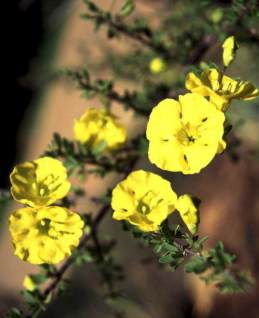Rhigozum obovatum
Rhigozum obovatum Burch.
Family: Bignoniaceae
Common names: Karoo rhigozum, Karoo gold, yellow pomegranate (Eng.); geelberggranaat, berggranaat (Afr.)
SA Tree No: 675
Introduction
Rhigozum obovatum is an ideal shrub or small tree to bring life to gardens in dry areas where water is in short supply and garden maintenance is low. Although it looks drab during a large part of the year, it turns into a spectacular showy sight after the first rains in spring or early summer when it is covered in a mass of bright yellow flowers. When rain is sporadic it may have several flushes of bloom.

Description
Description
This is a much-branched, spiny shrub or small tree 1.0-4.5 m high. The leaves are opposite or in a cluster, trifoliolate (compound leaf with three leaflets) or rarely simple, and they are borne on short, spine-tipped side shoots. The leaflets are obovate (egg-shaped and widest at the tips), 5-13 x 2-5 mm, greyish green, often finely notched, the margin is entire, rolled under, and the petiole is 2-6 mm long.

The flowers are produced singly along the branches where the leaves emerge. They are showy, bright yellow, tubular or funnel-shaped with 5 lobes. Flowers are followed by fruits which are pendulous, flattened, pod-like capsules, up to 80 mm long, white brownish in colour, and split along the flat surface when mature to release buff-coloured seeds with papery wings.
Conservation Status
Status
According to the Red List of South African Plants, this species is assessed as Least Concern (LC).
Distribution and habitat
Distribution description
This beautiful plant occurs in the central to eastern Karoo, extending into south eastern Lesotho and the southern Free State. It often grows on rocky outcrops (koppies) in this summer rainfall, but semi-arid region. Winters are cold and the plant is frost tolerant. It can be grown on the highveld provided it is not over-watered and it will flower there and produce viable seed.
Derivation of name and historical aspects
History
Rhigozum is derived from the Greek rhigios meaning stiff and ozos, a branch, a reference to the plant's rigid branches and obovatum is derived from the Latin word meaning egg-shaped with the widest point near the tip, referring to the leaf shape. The common name granaat or 'pomegranate' is due to the superficial resemblance of its flowers to those of the pomegranate, Punica granatum, but they are not related.
The Bignoniaceae is a fairly large family that is mostly concentrated in tropical America. Plants in this family often bear beautiful flowers, and include the jacaranda tree which is an alien invader that comes from Brazil, the showy African flame tree, Spathodea campanulata which comes from tropical Africa and the shrub, Cape honeysuckle, Tecomaria capensis, which is indigenous to this country.
Ecology
Ecology
The bright yellow colour of the flowers attracts bees. The winged seeds are dispersed by wind.
Uses
Use
It is heavily browsed by game and stock.
Growing Rhigozum obovatum
Grow
Rhigozum obovatum can withstand dry conditions and neglect but, for best results, lots of compost should be added to the soil. It is important to plant it in a well-drained soil and it looks best placed at the back of other shrubs so that its leggy base is hidden from view.
Rhigozum obovatum is easily propagated from seed sown from late spring to early autumn in a well-drained medium of 100% river sand or one part river sand to one part bark. Seed trays should be kept in a warm place and watered daily. After about 3 weeks the seed will start to germinate. Seedlings can be planted out after three months. (Werner Voigt pers. comm.).
References
- Carr, J.D. 1994. The propagation and cultivation of indigenous trees and shrubs on the Highveld. Sandton Nature Conservation and the Tree Society of Southern Africa, Natal.
- Coates Palgrave, M. 2002. Keith Coates Palgrave Trees of southern Africa, edn 3. Struik, Cape Town.
- Joffe, P. 1993. The gardener`s guide to South African plants. Tafelberg, Cape Town.
- Keith, P. & Coates Palgrave, M. 1985. Everyone`s guide to trees of South Africa. Struik, Cape Town.
- Le Roux, P.M., Kotzè, C.D., Nel, G.D. & Glen, H.F. 1994. Bossieveld. Department of Agriculture, Pretoria.
- Palmer, E. & Pitman, N. 1972 & 1973. Trees of southern Africa. 3 vols. Balkema, Cape Town.
- Van Wyk, Braam & Van Wyk, Piet. 1997. Field guide to trees of southern Africa. Struik, Cape Town.
Credits
Shireen Harris
Free State National Botanical Garden
September 2003
Plant Attributes:
Plant Type: Shrub, Tree
SA Distribution: Eastern Cape, Free State, Limpopo, Mpumalanga, Northern Cape, Western Cape
Soil type: Sandy, Clay, Loam
Flowering season: Spring, Early Summer
PH: Acid, Alkaline, Neutral
Flower colour: Yellow
Aspect: Full Sun
Gardening skill: Easy
Special Features:
Horticultural zones










Rate this article
Article well written and informative
Rate this plant
Is this an interesting plant?
Login to add your Comment
Back to topNot registered yet? Click here to register.